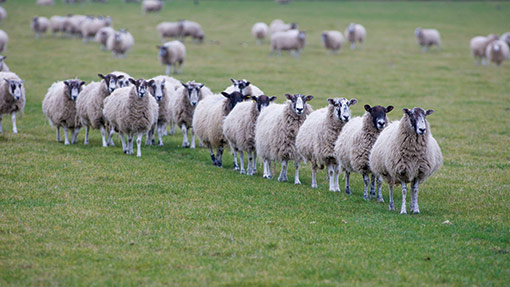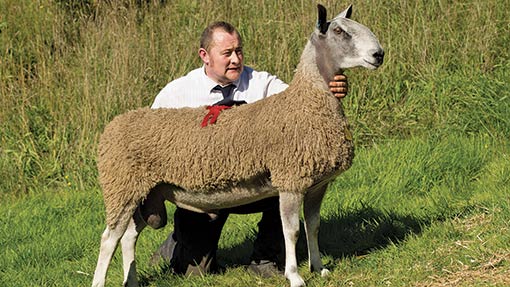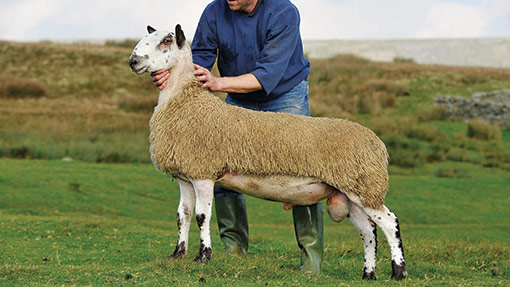Bluefaced Leicester breed: One name, two sheep

The Bluefaced Leicester is one of the most influential sheep breeds of modern times and its unique ability to sire female progeny of the Mule type remains unchallenged.
But is this exceptional breed, with its distinctive head and sought-after high-lustre fleece, now being replaced by a new version in a trend that some traditional devotees say is being driven purely by fashion?
No one fully understands why the Bluefaced Leicester has the ability to produce female progeny of the renowned Mule type with such valuable commercial qualities.
See also: New cow breed on the horizon
It is estimated that Bluefaced Leicester rams sire Mule-type females from more than 40 native breeds – all with the inherent ability to be prolific, milk well and be naturally good mothers.
Tracing back to the original Longwool “improver” rams developed by Robert Bakewell in Derbyshire almost 200 years ago, the Bluefaced Leicester is at the core of today’s sheep industry.
More than half the UK’s breeding ewes are Mules and are sired by Bluefaced Leicester rams.
From its stronghold in the North East and in Cumbria, where the pursuance of perfection has often become an all-consuming passion for generations of farming families, the addiction has spread far and wide, with Wales and Scotland now the home of many leading flocks.
By far the widest use of Bluefaced Leicester rams is seen across flocks of Swaledale, Blackface and Welsh Mountain ewes to produce the North of England Mule, the Scotch Mule and the Welsh Mule. In the case of the North of England Mule it’s estimated that more than 200,000 ewe lambs are sold at auction every autumn.
But breeders of Mule ewe lambs from north country hill-bred ewes have always prided themselves in one particular feature of the sheep they sell – their face markings.
In an age when farmers are encouraged to put performance figures first and eye-appeal second, breeders of North of England Mule sheep still set great store by the “pretty faces” of their lambs.
Bluefaced Leicester rams from bloodlines able to produce the colour needed to create the striking black and white “butterfly” markings on Mule lambs have always been among the most sought after.
But now a new version of the breed has become established. The crossing-type Bluefaced Leicester is a far cry from how the breed looked 30 years ago, with many sheep now carrying colour on the face – almost mirroring their cross-bred progeny.
Despite the split in the ranks of the breed over the two types being bred under the Bluefaced Leicester name, those responsible for producing this new version refute any claims that colour is taking their eye away from conformation.
Ironically, there was a time when a Bluefaced Leicester ram showing any sign of brown markings on its legs was considered unsuitable to breed from among the purists. But while premium prices have always been paid for North of England Mule ewe lambs with strikingly marked faces, it was soon obvious that change was inevitable.
When some Swaledale flocks bought the “reject” coloured tups and found they produced more colour in their progeny, it triggered a rethink by radical Bluefaced Leicester breeders about the type of tups they needed to breed.
The outcome has been the development of this new type of Bluefaced Leicester. It has created two breeds with one name – the traditional blue-head type with white legs and no trace of any colour and the crossing type with markings on both legs and face.
Exponents of both types defend their sheep vehemently. Breeders who have stayed true to the traditional type say they have steadily improved the conformation of their sheep. As one breeder commented: “There are some traditional Bluefaced Leicester tups with back ends as good as any Texel’s.”
Breeders of the crossing type believe they have sacrificed nothing in terms of conformation, but have gained much in producing rams capable of giving the desired face colour that Mule producers want in their lambs.
While rumblings continue about the rights and wrongs of what’s happened to the Bluefaced Leicester and whether or not it should be officially split into two breeds, what are the implications for commercial sheep producers?
Bluefaced Leicester Sheep Association chairman Carl Stephenson, who farms in Co Durham, is adamant that the Bluefaced Leicester is still one breed.
“It has developed into two types, but it’s not the colour on the skin that matters, it’s the blood that runs in the veins,” says Mr Stephenson.
“First and foremost these sheep have got to have the right conformation, a good mouth and a good skin and those who are breeding the crossing types carrying more colour are well aware of that.
“There’s still good demand for traditional Bluefaced Leicesters and last year saw a real resurgence, with a lot of traditional type tups bought for crossing,” says Mr Stephenson.
While that may be the case, there are widening divisions in the two “type” camps. Rumblings of the need for a separate breed society appear to have been quelled, but some shows are using two judges to assess the different types entered.
Although the traditional blue-headed type has long been able to produce coloured faces on its Mule lambs, the quest for more colour by using crossing-type tups could risk producing too much colour and even solid-faced Mule lambs.
While it’s clear that many Bluefaced Leicester flocks are now favouring breeding the crossing type because of the demand from the largest number of buyers, it’s equally vital that the gene pool of traditional types is protected.
In conclusion, while the colour on the faces of North of England Mules continues to be considered important it will drive demand for crossing-type rams.
Breeders of these tups are adamant that conformation will remain a priority, but it will be up to hill farmers who buy these rams – to use on Swaledale and Blackface ewes – to ensure they continue to produce top-quality Mule breeding sheep to meet the needs of commercial prime lamb producers.
The traditional breeder – Dewi Williams, Dolwen, Abergele, north Wales

At Builth Wells ram sale last year, the Williams family sold 20 Bluefaced Leicester rams for an average £1,000 a head – and all were the traditional type.
“We breed a lot of Mule lambs, so we use all our home-bred Bluefaced Leicester ram lambs in their first year on our Cheviot-type Welsh ewes and then sell them as shearlings,” says Dewi Williams.
His family has won the Welsh Mule ewe lamb championship at Ruthin market for five years.
Their tups are sold at Builth Wells, Kelso, Welshpool and Carlisle each autumn and have a wide reputation for producing sheep with good conformation.
“We want big, powerful-carcass sheep. We may not have the colour, but we’ve got everything else.
“We’re producing white-headed Mule lambs so we don’t need to concern ourselves with face colour. Our priority is carcass shape.”
Some traditional breeders believe those who have moved to producing crossing-type Bluefaced Leicesters will eventually have to return to the original gene pool. Others doubt that will happen.
The Williams family buy in tups, but say they dare not miss a sale.
“The gene pool of the traditional type is OK, but we’ve got to make sure we don’t miss an opportunity. It’s a lot more difficult to find the traditional-type tups we want than it was a few years ago,” he says.
The crossing-type breeder – James Porter, Richmond, North Yorkshire

“The demand is for the Bluefaced Leicester to produce good Mule sheep and the way things are going it’s looking as though the crossing-type will dominate the breed in the years to come.”
The Porter family’s Riddings flock of Bluefaced Leicesters has long been at the top of the breed.
Even as producers of Mule lambs, the Porters have had an enviable run of success, winning the Mule championship at the famous Hawes autumn sale 27 times.
James Porter says commercial Mule producers want conformation in their tups, but believes the crossing-type tups offer the complete package – shape and colour.
“Whatever the type of tup, it has to be a good sheep – and that’s becoming increasingly important.”
It was a mating between traditional sheep that produced the first purebreds carrying brown markings. They were originally denied registration, but the breed association finally relented – a decision which has given official status to the “crossing type”.
Mr Porter doesn’t accept the suggestion that more emphasis is being put on colour rather than conformation and is confident that commercial producers can rely on both traits being maintained by breeders of crossing-type Bluefaced Leicester tups.
“The demand is for the Bluefaced Leicester to produce good Mule sheep and the way things are going, it’s looking as though the crossing type will dominate the breed in the years to come.”
